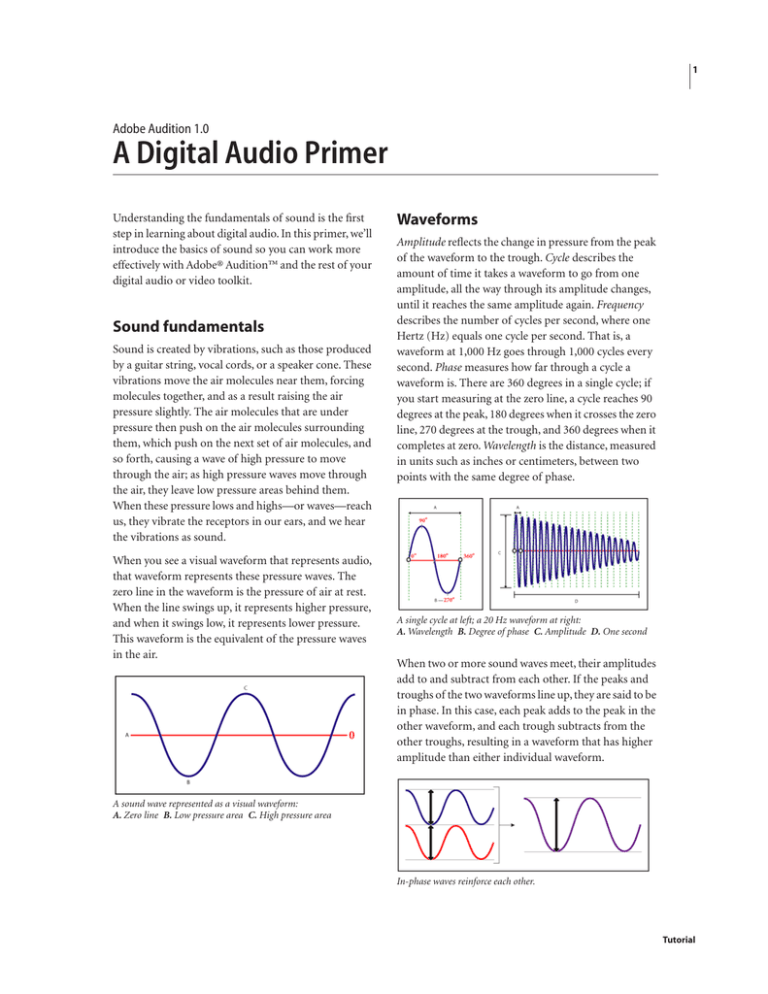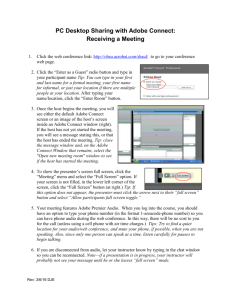
1
Adobe Audition 1.0
A Digital Audio Primer
Understanding the fundamentals of sound is the first
step in learning about digital audio. In this primer, we’ll
introduce the basics of sound so you can work more
effectively with Adobe® Audition™ and the rest of your
digital audio or video toolkit.
Sound fundamentals
Sound is created by vibrations, such as those produced
by a guitar string, vocal cords, or a speaker cone. These
vibrations move the air molecules near them, forcing
molecules together, and as a result raising the air
pressure slightly. The air molecules that are under
pressure then push on the air molecules surrounding
them, which push on the next set of air molecules, and
so forth, causing a wave of high pressure to move
through the air; as high pressure waves move through
the air, they leave low pressure areas behind them.
When these pressure lows and highs—or waves—reach
us, they vibrate the receptors in our ears, and we hear
the vibrations as sound.
When you see a visual waveform that represents audio,
that waveform represents these pressure waves. The
zero line in the waveform is the pressure of air at rest.
When the line swings up, it represents higher pressure,
and when it swings low, it represents lower pressure.
This waveform is the equivalent of the pressure waves
in the air.
Waveforms
Amplitude reflects the change in pressure from the peak
of the waveform to the trough. Cycle describes the
amount of time it takes a waveform to go from one
amplitude, all the way through its amplitude changes,
until it reaches the same amplitude again. Frequency
describes the number of cycles per second, where one
Hertz (Hz) equals one cycle per second. That is, a
waveform at 1,000 Hz goes through 1,000 cycles every
second. Phase measures how far through a cycle a
waveform is. There are 360 degrees in a single cycle; if
you start measuring at the zero line, a cycle reaches 90
degrees at the peak, 180 degrees when it crosses the zero
line, 270 degrees at the trough, and 360 degrees when it
completes at zero. Wavelength is the distance, measured
in units such as inches or centimeters, between two
points with the same degree of phase.
A single cycle at left; a 20 Hz waveform at right:
A. Wavelength B. Degree of phase C. Amplitude D. One second
When two or more sound waves meet, their amplitudes
add to and subtract from each other. If the peaks and
troughs of the two waveforms line up, they are said to be
in phase. In this case, each peak adds to the peak in the
other waveform, and each trough subtracts from the
other troughs, resulting in a waveform that has higher
amplitude than either individual waveform.
A sound wave represented as a visual waveform:
A. Zero line B. Low pressure area C. High pressure area
In-phase waves reinforce each other.
Tutorial
ADOBE AUDITION 1.0 2
A Digital Audio Primer
Sometimes the peaks of one waveform match up with
the troughs of the other waveform. The peaks and the
troughs will cancel each other out, resulting in no
waveform at all. Such waveforms are said to be 180
degrees out of phase.
Out-of-phase waves cancel each other out.
In all other cases, the waves are out of phase by some
other amount. This results in a waveform that is more
complex than either of the original waveforms;
continuing to add waves makes a more and more
complicated waveform. Keep in mind, however, that a
single instrument can create extremely complex waves
on its own because of the unique structure of the
instrument, which is why a violin and a trumpet sound
different even when playing the same note. When you
see music, voice, noise, or other complicated sound
represented by a waveform, you are seeing the result of
adding all of the waveforms from each sound together.
Digital audio
Unlike analog storage media such as magnetic tape and
vinyl records, computers store audio information
digitally as a series of zeroes and ones. In digital storage,
the original waveform is broken up into individual
samples. This is known as digitizing or sampling the
audio, and is sometimes called analog-to-digital
conversion. The sampling rate defines how often a
sample is taken. For example, CD-quality sound has
44,100 samples for each second of a waveform.
Sampling rate
The higher the sampling rate, the closer the shape of the
digital waveform will be to that of the original analog
waveform. Low sampling rates limit the range of
frequencies that can be recorded, which can result in a
recording that poorly represents the original sound.
Two sample rates:
A. A low sample rate that distorts the original sound wave. B. A high
sample rate that perfectly reproduces the original sound wave.
Two simple waves combine to create a complex wave.
Analog audio
A microphone works by converting the pressure waves
of sound into changes in voltage on a wire. These
changes in voltage match the pressure waves of the
original sound: high pressure is represented by positive
voltage, and low pressure is represented by negative
voltage. Voltages travel down the microphone wire and
can be recorded on to tape as changes in magnetic
strength or on to vinyl records as changes in amplitude
in the groove. A speaker works like a microphone in
reverse, taking the voltage signals from a microphone or
recording and vibrating to re-create the pressure wave.
The sampling rate limits the frequency range of the
audio file; to reproduce a given frequency, the sampling
rate must be at least twice that frequency. For example,
if the audio contains audible frequencies as high as
8,000 Hz, you need a sample rate of 16,000 samples per
second to represent this audio accurately in digital
form. This calculation comes from the Nyquist
Theorem, and the highest frequency that can be reproduced by a given sample rate is known as the Nyquist
Frequency. CDs have a sample rate of 44,100 samples
per second that allows sampling up to 22,050 Hz, which
is higher than the limit of human hearing, 20,000 Hz.
Tutorial
ADOBE AUDITION 1.0 3
A Digital Audio Primer
Bit depth
Just as the sample rate determines the frequency
resolution, the bit depth determines the amplitude
resolution. A bit is a computer term meaning a single
number that can have a value of either zero or one. A
single bit can represent two states, such as on and off.
Two bits together can represent four different states:
zero/zero, one/zero, zero/one, or one/one. Each
additional bit doubles the number of states that can be
represented, so a third bit can represent eight states, a
fourth 16, and so on.
Amplitude resolution is just as important as frequency
resolution. Higher bit-depth means greater dynamic
range, a lower noise floor, and higher fidelity. When a
waveform is sampled, each sample is assigned the
amplitude value closest to the original analog wave.
With a resolution of two bits, each sample can have one
of only four possible amplitude positions. With threebit resolution, each sample has eight possible amplitude
values. CD-quality sound is 16-bit, which means that
each sample has 65,536 possible amplitude values.
DVD-quality sound is 24-bit, which means that each
sample has 16,777,216 possible amplitude values.
Higher bit depths provide greater dynamic range.
Where Adobe Audition
fits into the process
When you record audio on your computer, Adobe
Audition tells the sound card to start the recording
process and specifies what sampling rate and bit depth
it should use. The hardware that the sound card uses
determines the sample rates and bit depths that it is
capable of recording. Most cards are capable of
recording and playback at CD-quality settings, and
often at other settings as well, such as a 48 kHz sample
rate, which is common in film and video postproduction. Your sound card probably has both Line In
and Microphone In ports through which it can accept
analog signals. The sound card samples the audio at the
specified sample rate and assigns each sample an
amplitude value. Adobe Audition stores each sample in
sequence until you stop recording. Once you've
recorded the audio, you can use Adobe Audition to edit
the audio or save it to disk as a file.
When you play a file in Adobe Audition, the process
happens in reverse. Adobe Audition tells the sound card
that it is going to play a file, and sends the samples to the
sound card. The sound card reconstructs the original
waveform and sends it out as an analog signal from the
Line Out port to your speakers.
An audio file on your hard drive, such as a WAV file,
consists of a small header telling the audio program
what the sample rate and bit depth of the audio is,
and then a long series of numbers, one for each sample.
These files can be very large. At 44,100 samples per
second and 16 bits per sample, for example, a file
includes 705,600 bits per second. This equals
86 kilobytes per second and more than 5 megabytes
per minute. Stereo sound has two channels, so
CD-quality sound requires a little more than
10 megabytes per minute.
Tutorial
ADOBE AUDITION 1.0 4
A Digital Audio Primer
Introducing MIDI
Conclusion
In contrast to a digital audio file, a MIDI file might be
as small as 10 kilobytes per minute, so you can store up
to one hundred minutes of MIDI per megabyte. MIDI
and digital audio are fundamentally different: digital
audio is a digital representation of a sound wave, MIDI
is a language of instructions for musical instruments.
A digital audio file seeks to exactly represent an audio
event just like a tape recorder, whether it's a musical
performance, a person talking, or any other sound.
MIDI, on the other hand, is more like sheet music.
It acts as instructions for the re-creation of a musical
selection. MIDI files record information such as the
note to be played, the instrument to play the note on,
the pan and volume of that particular note, and so on.
When a MIDI file is played back, the sound card takes
this information and uses its synthesizer to re-create the
note on the right instrument. Because every synthesizer
sounds different, the MIDI file will sound different
depending on what sound card plays it back. Also, a
MIDI file cannot record sounds that cannot be resynthesized from short instructions, such as the human
voice. MIDI support in Adobe Audition is limited to
playback of MIDI files.
To summarize, the process of sampling or digitizing
audio starts with a pressure wave in the air. A microphone converts this pressure wave into voltage variations. An analog-to-digital converter, such as those
found in a sound card, samples the signal at the sample
rate and bit depth you choose. Once the sound has been
transformed into digital information, Adobe Audition
can record, edit, alter the sound of, mix, and save your
digital audio files. The possibilities for manipulation of
digital audio within Adobe Audition are limited only by
your imagination.
Adobe, the Adobe logo, and Adobe Audition are either registered trademarks or trademarks of Adobe Systems Incorporated in the United States
and/or other countries. Windows is either a registered trademark or trademark of Microsoft Corporation in the United States and/or other countries. Macintosh is a trademark of Apple Computer, Inc., registered in the United States and other countries. All other trademarks are the property
of their respective owners.
©2003 Adobe Systems Incorporated. All rights reserved.



